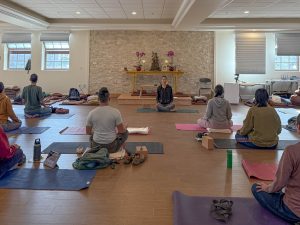
From March 10–13, 2025, DRBU students, staff, and faculty set aside textbooks and regular duties to immerse themselves in the eight limbs of Patañjali’s yoga alongside parallel Yogācāra practices. The university-wide Contemplative Exercise Immersion (CEI), hosted in the Earth Store Hall at the City of Ten Thousand Buddhas, offered participants a rare opportunity to explore the connections between these complementary traditions through both theory and practice.
“Perform actions while established in yoga! Abandon attachment, Arjuna, and be equanimous in success and failure. Yoga is said to be equanimity,” reads a quote from the Bhagavadgītā offered to students as a guiding principle encapsulating the spirit of this spring’s CEI.
Led by DRBU staff member and yoginī Sandy Lamerson, along with faculty members Doug Powers, Lauren Bausch, Franklyn Wu, Huali Yuan, and Sue Rounds, the yoga-based program guided participants through Patañjali’s comprehensive path—from ethical practices (yama) and observances (niyama), through posture (āsana) and breath control (prāṇāyāma), to the internal practices of fixation, meditation, and samādhi.
The program also explored how Yogācāra’s teachings on consciousness complement yoga practice by revealing how the mind constructs what is perceived and how liberation comes through nongrasping awareness.
DRBU’s semesterly CEI reflects the university’s commitment to educating the whole person, balancing intellectual study with self-discovery and providing what the university calls a crucial “laboratory experience” for direct experiential learning.
Participants of this semester’s CEI reported profound experiences during the optional evening sessions, where the quieter atmosphere allowed for deeper contemplative practice. Many students noted how the immersion helped them understand theoretical concepts they had previously encountered only in texts. “Experiencing yogaś citta-vṛtti-nirodhaḥ—the cessation of the turnings of mind—even momentarily brought the ancient teachings to life in ways that reading alone never could,” shared one student. Faculty observed that this temporary departure from academic routines fostered a unique sense of community, as everyone worked together toward deeper awareness and understanding of these transformative practices.
